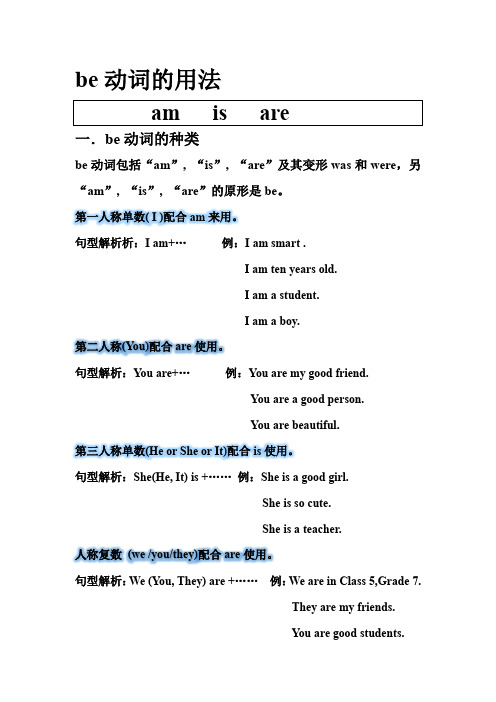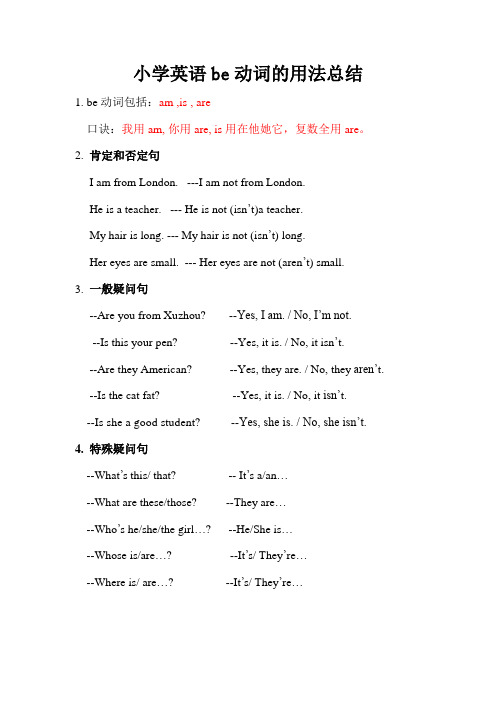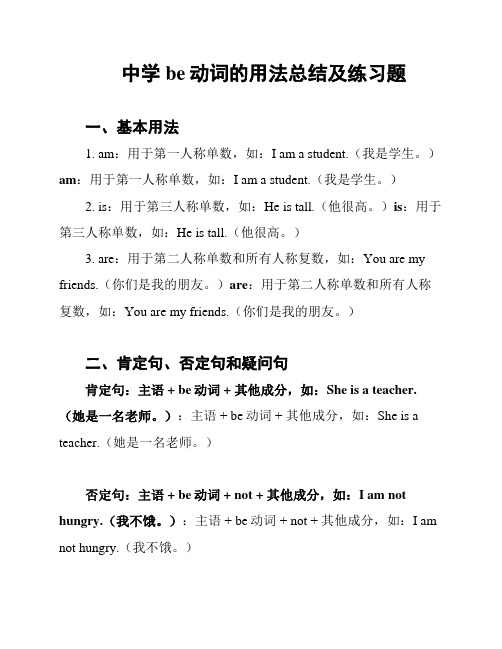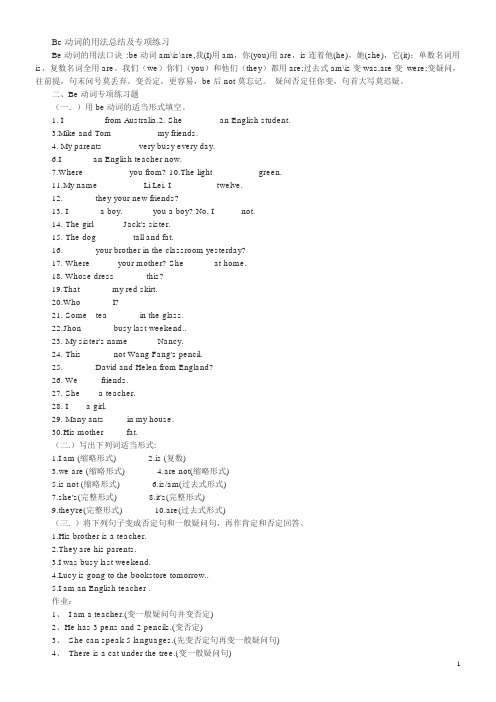(完整word版)be动词的用法总结及练习,推荐文档
be动词的用法总结及练习

be动词的用法am is are一.be动词的种类be动词包括“am”, “is”, “are”及其变形was和were,另“am”, “is”, “are”的原形是be。
第一人称单数( I )配合am来用。
句型解析析:I am+…例:I am smart .I am ten years old.I am a student.I am a boy.第二人称(You)配合are使用。
句型解析:Y ou are+…例:You are my good friend.You are a good person.You are beautiful.第三人称单数(He or She or It)配合is使用。
句型解析:She(He, It) is +……例:She is a good girl.She is so cute.She is a teacher.人称复数(we /you/they)配合are使用。
句型解析:We (You, They) are +……例:We are in Class 5,Grade 7.They are my friends.You are good students.综合解析:当使用be动词的时候,前面请先加上第几人称。
be动词前面的人称,是不可随意替换的。
例如:I am, You are, She is,并不会出现I is, Y ou am, She are 这样的情形。
Be的用法口诀I用am;you,we ,they 都用are, is连着he,she,it;单数名词用is,复数名词全用are。
变疑问,往前提,句末问号莫丢弃。
变否定,更容易,be后not莫忘记。
疑问否定任你变,句首大写莫迟疑注:I’m=I am 我是she’s=she is 她是He’s=he is 他是It’s=it is 它是you’re =you are 你是(复数形式)they’re=they are 他(她;它)们是isn’t=is not 不是(单数形式)he’s not =he is not=he isn’t他不是含be动词的一般疑问句,否定句,以及回答1.以be动词开头的一般疑问句的结构为:be动词+主语+表语名词、数词等)。
小学英语be动词的用法总结及练习题

小学英语be动词的用法总结1. be动词包括:am ,is , are口诀:我用am, 你用are, is用在他她它,复数全用are。
2. 肯定和否定句I am from London. ---I am not from London.He is a teacher. --- He is not (isn’t)a teacher.My hair is long. --- My hair is not (isn’t) long.Her eyes are small. --- Her eyes are not (aren’t) small.3. 一般疑问句--Are you from Xuzhou? --Yes, I am. / No, I’m not.--Is this your pen? --Yes, it is. / No, it isn’t.--Are they American? --Yes, they are. / No, they aren’t. --Is the cat fat? --Yes, it is. / No, it isn’t.--Is she a good student? --Yes, she is. / No, she isn’t.4. 特殊疑问句--What’s this/ that? -- It’s a/an…--What are these/those? --They are…--Who’s he/she/the girl…? --He/She is…--Whose is/are…? --It’s/ They’re…--Where is/ are…? --It’s/ They’re…小学英语be动词练习一、用恰当的be动词填空1. I ______ a boy. ______ you a boy? No, I _____ not.2. ______ David and Helen from England?3. The dog _______ tall and fat.4. You, he and I ______ from China.5. ______ your brother in the classroom?6. --Where _____ your mother? --She ______ at home.7. How _______ your father?8. Mike and Liu Tao ______ at school.9. Whose dress ______ this?10. Whose socks ______ they?11. Here _____ a cake for you.12. Here ______ some oranges for you.二、句型转换1. Our school is beautiful.否定句:______________________________________ 一般疑问句:__________________________________ 2. The bike is behind the tree.否定句:______________________________________ 一般疑问句:__________________________________ 对划线部分提问:__________________________。
高中be动词的用法总结及练习题

高中be动词的用法总结及练习题在英语语法中,be动词是最基础、最常用的动词之一。
它有很多特殊的用法和结构,需要我们仔细研究和掌握。
本文将总结高中阶段be动词的用法,并提供一些练题供大家巩固知识。
1. be动词的基本用法- 表示存在和状态:例如,“I am happy.”(我很快乐。
)- 表示身份和职业:例如,“She is a doctor.”(她是一名医生。
)- 表示性格和特点:例如,“He is tall and handsome.”(他又高又帅。
)- 表示所属关系:例如,“This book is mine.”(这本书是我的。
)2. be动词的时态形式- 一般现在时:am/is/are- 一般过去时:was/were- 现在进行时:am/is/are + 动词-ing- 过去进行时:was/were + 动词-ing- 现在完成时:have/has been- 过去完成时:had been- 将来时:will be3. be动词的否定形式和疑问形式- 否定形式:在be动词后加not,如“am not/is not/are not”- 疑问形式:将be动词置于句首,如“Am/Is/Are + 主语+ ...?”练题1. 用适当的be动词填空:- I __________ a student.- They ___________ happy.- She ___________ at home.- We ___________ in the park.2. 改写下列句子为否定句和疑问句:- He is a teacher.- They are playing football.- You are my best friend.3. 选择正确的be动词填空:- _____ she your sister? (Am/Is/Are)- My parents _______ doctors. (is/are)- We _______ going to the beach tomorrow. (is/are) 参考答案1. 用适当的be动词填空:- I am a student.- They are happy.- She is at home.- We are in the park.2. 改写下列句子为否定句和疑问句:- He is not a teacher. Is he a teacher?- They are not playing football. Are they playing football?- You are not my best friend. Are you my best friend?3. 选择正确的be动词填空:- Is she your sister?- My parents are doctors.- We are going to the beach tomorrow.希望通过本文的总结和练习,大家对高中阶段be动词的用法有更清晰的理解。
中学be动词的用法总结及练习题

中学be动词的用法总结及练习题一、基本用法1. am:用于第一人称单数,如:I am a student.(我是学生。
)am:用于第一人称单数,如:I am a student.(我是学生。
)2. is:用于第三人称单数,如:He is tall.(他很高。
)is:用于第三人称单数,如:He is tall.(他很高。
)3. are:用于第二人称单数和所有人称复数,如:You are my friends.(你们是我的朋友。
)are:用于第二人称单数和所有人称复数,如:You are my friends.(你们是我的朋友。
)二、肯定句、否定句和疑问句肯定句:主语 + be动词 + 其他成分,如:She is a teacher.(她是一名老师。
):主语 + be动词 + 其他成分,如:She is a teacher.(她是一名老师。
)否定句:主语 + be动词 + not + 其他成分,如:I am not hungry.(我不饿。
):主语 + be动词 + not + 其他成分,如:I am not hungry.(我不饿。
)一般疑问句:Be动词 + 主语 + 其他成分,如:Are you ready?(你准备好了吗?):Be动词 + 主语 + 其他成分,如:Are you ready?(你准备好了吗?)三、特殊用法1. be动词+形容词:表示主语的状态或特性。
如:She is happy.(她很开心。
)be动词+形容词:表示主语的状态或特性。
如:She is happy.(她很开心。
)2. be动词+名词:表示主语的身份、职业等。
如:He is a doctor.(他是一名医生。
)be动词+名词:表示主语的身份、职业等。
如:He is a doctor.(他是一名医生。
)3. be动词+介词短语:表示主语所在的位置或状态。
如:They are in the park.(他们在公园里。
)be动词+介词短语:表示主语所在的位置或状态。
(完整word版)Be动词的用法总结及专项练习,推荐文档

Be动词的用法总结及专项练习Be动词的用法口诀:be动词am\is\are,我(I)用am,你(you)用are,is连着他(he),她(she),它(it);单数名词用is,复数名词全用are。
我们(we)你们(you)和他们(they)都用are;过去式am\is变was,are变were;变疑问,往前提,句末问号莫丢弃。
变否定,更容易,be后not莫忘记。
疑问否定任你变,句首大写莫迟疑。
二、Be动词专项练习题(一.)用be动词的适当形式填空。
1. I ________ from Australia.2. She _______ an English student.3.Mike and Tom _________ my friends.4. My parents _______ very busy every day.6.I ______ an English teacher now.7.Where _________ you from? 10.The light _________ green.11.My name _________ Li Lei. I _________ twelve.12._______they your new friends?13. I ______ a boy. ______you a boy? No, I _____ not.14. The girl______ Jack's sister.15. The dog _______ tall and fat.16. ______ your brother in the classroom yesterday?17. Where _____ your mother? She ______at home.18. Whose dress ______ this?19.That ______ my red skirt.20.Who ______ I?21. Some tea ______ in the glass.22.Jhon ______ busy last weekend..23. My sister's name ______Nancy.24. This ______ not Wang Fang's pencil.25. ______ David and Helen from England?26. We ____ friends.27. She ___ a teacher.28. I ___ a girl.29. Many ants ____ in my house.30.His mother ____ fat.(二.)写出下列词适当形式:1.I am (缩略形式) ______2.is (复数)______3.we are (缩略形式) ______4.are not(缩略形式) ______5.is not (缩略形式) ______6.is/am(过去式形式) ______7.she's(完整形式) ______ 8.it's(完整形式) ______9.they're(完整形式) ______ 10.are(过去式形式) ______(三. )将下列句子变成否定句和一般疑问句,再作肯定和否定回答。
(完整word版)be动词用法和练习题

Be 动词专项练习be动词的一般现在时有三种形式,即:am, is, are(翻译为“是”,“在”)1. 如果主语是第一人称I(我)时,be动词用am。
如:I am a student. 我是一名学生。
I am 还可缩写成I'm。
如:I'm David. 我是大卫。
am 与not 不能缩写。
如:I am not a bad boy.2. 如果主语是you (你,你们), they (他们,它们,她们)或名词复数(两个以上的人或物)时,be动词必须用are。
如:Are you twelve? 你是十二岁吗?Tom and Lily are good friends. 汤姆和莉莉是好朋友。
They are at school. 他们在学校。
are与主语还可缩写。
如:We are= We're,They are =They're, You are = You're。
而are与not可缩写成aren't。
如:They aren't students. 他们不是学生。
3. 如果主语是单数名词、不可数名词或单数第三人称代词(he, she, it)时,be动词用is。
如:My mother is a teacher. 我的妈妈是一名老师。
He is a student. 他是一名学生。
is也可与主语缩写,如: He is = He's, My mother is = My mother's等。
但是This is不可缩写。
而is与not可缩写成isn't。
如:This isn't a book. 这不是一本书。
4. 句中含有be动词的陈述句变一般疑问句。
把be动词提到句首,be动词要变大写。
注意第一人称变第二人称。
回答时用yes或no表示,结构:Yes, 主语+be动词,No,主语+be动词+not。
如:It is a book. 变为:Is it a book?5. 句中含有be动词的肯定陈述句变否定句。
be动词用法和练习题
be动词用法和练习题be动词是英语语法中最基础、最常用的动词之一。
它的形式包括am、is、are、was、were、been等。
在句子中,be动词通常用来表示主语的状态、特征、身份、职业、国籍等等。
本文将介绍be动词的用法,并附上一些练习题供读者巩固掌握。
一、be动词的基本用法1. 表示身份和职业例如:- I am a student.(我是一名学生。
)- He is a doctor.(他是一名医生。
)2. 表示状态和特征例如:- She is tired.(她累了。
)- The house is big.(这所房子很大。
)3. 表示存在和位置例如:- They are at home.(他们在家。
)- The book is on the table.(书在桌子上。
)4. 表示时间和日期例如:- It is Monday today.(今天是星期一。
)- The party is on Friday.(聚会在星期五。
)5. 表示感觉和情绪例如:- We are happy.(我们很开心。
)- She is sad.(她很伤心。
)二、be动词的时态变化1. 现在时- am用于第一人称单数,即“I am”表示“我是”。
- is用于第三人称单数,即“He/She/It is”表示“他/她/它是”。
- are用于第一人称复数和第二人称单数/复数,即“We/You/They are”表示“我们/你们/他们是”。
2. 过去时- was用于第一人称单数和第三人称单数,即“I/He/She/It was”表示“我/他/她/它是/在过去是”。
- were用于第一人称复数和第二人称单数/复数,即“We/You/They were”表示“我们/你们/他们是/在过去是”。
3. 将来时be动词不用于表示将来时态,而是与助动词will或be going to连用。
例如:- I will be a teacher in the future.(将来我会成为一名教师。
(完整版)小学英语-Be动词的用法总结及专项练习,推荐文档
星光教育暑期班英语内部资料一.Be 动词的用法总结及专项练习Be 动词的用法口诀:be 动词am\is\are,我(I)用am,你(you)用are,is 连着他(he),她(she),它(it);单数名词用is,复数名词全用are。
我们(we)你们(you)和他们(they)都用are;过去式am\is 变was,are 变were;变疑问,往前提,句末问号莫丢弃。
变否定,更容易,be 后not 莫忘记。
疑问否定任你变,句首大写莫迟疑。
二、Be 动词专项练习题(一.)用be 动词的适当形式填空。
1.I from Australia.2.She an English student.3.Mike and Tom my friends.4.My parents very busy every day.6.I an English teacher now.7.Where you from?10.The light green.11.My name Li Lei. I twelve.12.they your new friends?13.I a boy. you a boy? No, I not.14.The girl Jack's sister.15.The dog tall and fat.16.your brother in the classroom yesterday?17.Where your mother? She at home.18.Whose dress this?19.That my red skirt.20.Who I?21.Some tea in the glass.22.Jhon busy last weekend..23.My sister's name Nancy.24.This not Wang Fang's pencil.25.David and Helen from England?26.We friends.27.She a teacher.28.I a girl.29.Many ants in my house.30.His mother fat.(二.)写出下列词适当形式:1.I am (缩略形式)2.is (复数)3.we are (缩略形式)4.are not(缩略形式)5.is not (缩略形式)6.is/am(过去式形式)7.she's(完整形式) 8.it's(完整形式)9.they're(完整形式) 10.are(过去式形式)(三. )将下列句子变成否定句和一般疑问句,再作肯定和否定回答。
Be动词的用法总结及专项练习
Be动词的用法总结及专项练习Be动词是英语中最常用的动词之一,在句子中扮演着格外重要的角色。
下面我们来总结一下Be动词的用法,并进行一些专项练习。
一、Be动词的基本用法1. Be动词的基本形式有三个:am(单数第一人称)、is(单数第三人称)、are(复数和全部人称)。
例如:I am a student.He is my brother.We are friends.2. Be动词用于构成进行时态。
例如:She is watching TV.They are playing basketball.3. Be动词用于构成一般时态的被动语态。
例如:The book is read by me.The house was built by my grandfather.4. Be动词用于构成一般现在时的陈述句和疑问句。
第1页/共4页例如:陈述句:She is a doctor.疑问句:Is she a doctor?5. Be动词用于表达存在、位置、状态等。
例如:There is a beautiful garden near my house. The cat is on the chair.I am happy.二、Be动词的进一步用法1. Be动词用于表示某事物的特性、性格等。
例如:She is beautiful.He is a kind person.They are smart students.2. Be动词用于表示事实、真理等。
例如:Water boils at 100 degrees Celsius.The earth is round.English is spoken all over the world.3. Be动词用于表示拥有、属于等。
例如:This car is mine.The house is his.These books are ours.4. Be动词用于构成被动语态。
Be动词的用法及练习
Be动词的用法及练习一、Be动词的基本概念和形式在英语中,be动词是表示状态或关系的动词。
它有两种形式:am、is、are和was、were。
根据主语的不同,be动词的形式也会发生变化。
1. 当主语为第一人称单数(I)时,be动词用am。
比如:I am a student.2. 当主语为第三人称单数(he,she,it)时,be动词用is。
比如:She is a doctor.3. 当主语为第一人称复数(we)、第二人称单数和复数(you)以及第三人称复数(they)时,be动词用are。
比如:They are in the park.二、Be动词的用法1. 表示状态或特征。
比如:The apple is red. (这个苹果是红色的。
)2. 表示存在或位置。
比如:There is a book on the table. (桌子上有一本书。
)3. 表示进行或变化。
比如:She is studying now. (她现在正在学习。
)三、练习题1. 选择正确的be动词形式填空。
a) I ________ (am/is/are) a student.b) He ________ (am/is/are) reading a book.c) They ________ (am/is/are) waiting for the bus.答案:a) am; b) is; c) are.2. 根据中文翻译填写英文句子。
a) She ________ (是) a doctor. She is a doctor.b) They ________ (正在) having a meeting. They are having a meeting.c) I ________ (不是) a student. I am not a student. 答案:a) is; b) are; c) am not.3. 根据句意填写正确的be动词形式。
- 1、下载文档前请自行甄别文档内容的完整性,平台不提供额外的编辑、内容补充、找答案等附加服务。
- 2、"仅部分预览"的文档,不可在线预览部分如存在完整性等问题,可反馈申请退款(可完整预览的文档不适用该条件!)。
- 3、如文档侵犯您的权益,请联系客服反馈,我们会尽快为您处理(人工客服工作时间:9:00-18:30)。
be动词的用法
am is are
一.be动词的种类
be动词包括“am”, “is”, “are”及其变形was和were,另“am”, “is”, “are”的原形是be。
第一人称单数( I )配合am来用。
句型解析析:I am+…例:I am smart .
I am ten years old.
I am a student.
I am a boy.
第二人称(You)配合are使用。
句型解析:Y ou are+…例:You are my good friend.
You are a good person.
You are beautiful.
第三人称单数(He or She or It)配合is使用。
句型解析:She(He, It) is +……例:She is a good girl.
She is so cute.
She is a teacher.
人称复数(we /you/they)配合are使用。
句型解析:We (You, They) are +……例:We are in Class 5,Grade 7.
They are my friends.
You are good students.
综合解析:
当使用be动词的时候,前面请先加上第几人称。
be动词前面的人称,是不可随意替换的。
例如:I am, You are, She is,并不会出现I is, Y ou am, She are 这样的情形。
Be的用法口诀
I用am;you,we ,they 都用are, is连着he,she,it;
单数名词用is,复数名词全用are。
变疑问,往前提,句末问号莫丢弃。
变否定,更容易,be后not莫忘记。
疑问否定任你变,句首大写莫迟疑
注:
I’m=I am 我是
she’s=she is 她是
He’s=he is 他是
It’s=it is 它是
you’re =you are 你是(复数形式)
they’re=they are 他(她;它)们是
isn’t=is not 不是(单数形式)
he’s not =he is not=he isn’t他不是
含be动词的一般疑问句,否定句,以及回答
1.以be动词开头的一般疑问句的结构为:be动词+主语+表语
名词、数词等)。
例如:—Is this your pencil?这是你的铅笔吗?
—Yes,it is. / No,it isn’t.是的,是我的。
/ 不,不是我的。
2.将肯定的陈述句变为否定的陈述句的方法:1找到be动词,在be 动词之后加上not就可以了,其他的不变。
例如:(肯定的陈述句)This is my bike.
(否定的陈述句)This is not my bike.---- This isn`t my bike.
3. 将陈述句变为一般疑问句时,应将be动词移到主语之前并大写其首字母,句末标点用问号,其他句子成分照搬。
(注意,i 要变为you,my要变成变your,其他人称不变)。
例如:This is my bike. 这是我的自行车。
→Is this your bike?这是你的自行车吗?
4. 一般疑问句通常用yes或no来回答。
例如:—Are you Gina?你是吉娜吗?
—Yes,I am. / No,I’m not.是的,我是。
/ 不,我不是。
有些一般疑问句也可以用其他形式来回答。
例如:
—Is this Gina’s book?这是吉娜的书吗?
—Sorry,I don’t know.对不起,我不知道。
be动词练习:
一. 用括号中适当的词填空。
1. I ________(am, are, is) from Australia.
2. She _______ (am, are, is) a student.
3. Jane and Tom _________(am, is, are) my friends.
4. My parents _______ (am, is, are) very busy every day.
5. _______ (Are, Is, Do, Does) there a Chinese school in New York?
6. _______ (Be, Are, Were, Was) they excited when he heard the news?
7. There _____ (be) some glasses on it.
8. If he _____ (be) free tomorrow, he will go with us.
二. 用所be动词的适当形式填空。
1. A: Where _______the post office.
B: It ________ behind the building.
2. A: _______ you miss Black?
B: Yes, I ______.
3. It _____ a shirt, it _______(not) a skirt.
4. There ________ a big playground in our school.
5. There ______ many books in my schoolbag.
6. There _________ some fish in the box.
7. _______ there any chairs in the classroom?
8. You’d better _______ early next time.
三. 改写下列句子。
1. Bob is on the football team.
否定句:
一般疑问句:
回答:
2. They are in the teacher’s office.
否定句:
一般疑问句:
回答:
3. It is sunny today.
否定句:
一般疑问句:
回答:
四、用be动词的适当形式填空
1. I _______ at school just now.
2. He ________ at the camp last week.
3. We ________ students two years ago.
4. They ________ on the farm a moment ago.
5. Yang Ling ________ eleven years old last year.
6. There ________ an apple on the plate yesterday.
7. There ________ some milk in the fridge on Sunday.
8. The mobile phone _______ on the sofa yesterday evening.
五、句型转换
1. It was exciting.
___________________________________________(否定句__________________________________________(疑问句)______________________________________(肯、否定回答)
2. All the students were very excited
___________________________________________(否定句)__________________________________________(疑问句)______________________________________(肯、否定回答)
3. They were in his pocket.
___________________________________________(否定句)___________________________________________(疑问句)___________________________________ (肯、否定回答)六、Be动词的过去时练习
(一)、用be动词的适当形式填空
1. I ______ an English teacher now.
2. She _______ happy yesterday.
3. They _______ glad to see each other last month.
4. Helen and Nancy ________ good friends.
5. The little dog _____ two years old this year
6. Look, there ________ lots of grapes here.
7. There ________ a sign on the chair on Monday..
8. Today _____ the second of June. Yesterday ______ the first of June. It _____ Children’s Day. All the students ______ very excited.。
